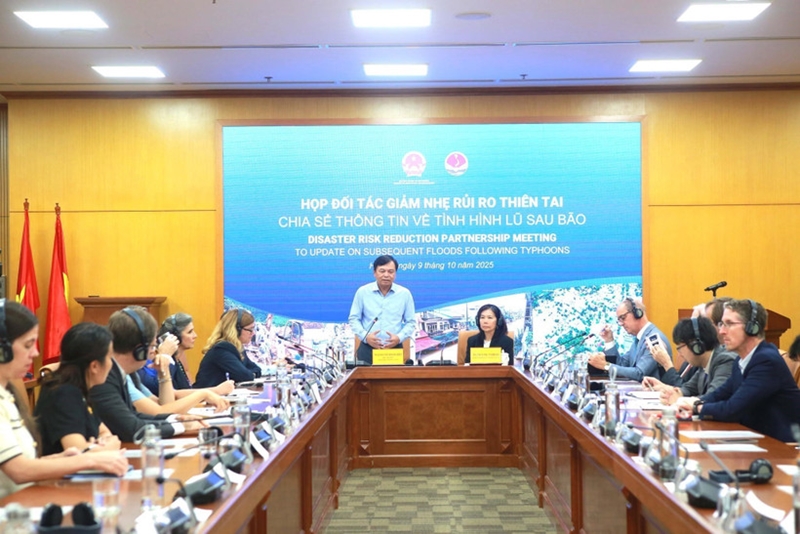Speaking at the disaster risk reduction partnership meeting to update on subsequent floods following typhoons held in Hanoi, the official expressed sincere gratitude to all international partners, organizations, and individuals for their support to Vietnam in disaster prevention and risk mitigation. In 2024, partners contributed about 25 million USD and thousands of tons of relief goods, helping communities recover from severe disasters.
    |
 |
|
Deputy Minister of Agriculture and Environment Nguyen Hoang Hiep meets with members of the DRRP to share updates on post-storm flooding and discuss emergency relief measures. |
He said in 2025, natural disasters in Vietnam have continued to grow more complex and extreme. Despite the country’s extensive efforts in prevention and response, many disasters have struck with an intensity exceeding the response capacity of both local communities and existing prevention systems.
Recent storms and their remnants have caused serious damage, with total losses estimated at 35 trillion VND (around 1.33 billion USD) — nearly half of last year’s total. The disasters have also reduced national GDP growth by about 0.2 percentage points, he noted.
According to the deputy minister, disaster patterns have shifted significantly. Some storms now move rapidly at sea but slowly over land, bringing prolonged heavy rains. Late-season storms have also been striking northern provinces — a rare occurrence in previous years.
Through the meeting, Vietnam seeks to share updates on the disaster situation and priority support needs, as well as to coordinate mechanisms for the swift and efficient transport and distribution of relief supplies, the official added.
Essential supplies such as food, clean water, water purifiers, household items, and disinfectants are urgently needed, while housing and production recovery remain top priorities as nearly all homes in flood-hit areas have been damaged and require repair, Hiep said.
Although the Government will issue a resolution on recovery support, domestic resources are limited. Therefore, contributions from international organizations remain crucial, Hiep stressed, adding that key infrastructure such as clinics, schools, and local government offices must be restored quickly to stabilize livelihoods and maintain public services.
Regarding coordination, the official proposed maintaining the 2024 approach, including joint field assessment missions. He suggested that, if possible, teams begin visiting the hardest-hit areas as early as October 10 to assign specific tasks.
U.N. Resident Coordinator in Vietnam Pauline Tamesis expressed deep sympathy for the loss of lives and property caused by the recent disasters and reaffirmed the UN’s commitment to stand with Vietnam not only in emergency response but also in long-term resilience programs.
Drawing lessons from the response to Typhoon Yagi in 2024, she emphasized the importance of synchronized coordination so that each partner can leverage its own advantage to ensure assistance reaches the right people, at the right time, and according to actual needs.
Participating partners expressed their wish to soon dispatch assessment missions to develop timely, effective, and well-coordinated support plans.
Hiep assigned the Department of Dyke Management and Natural Disaster Prevention and Control to promptly deploy three working groups to Tuyen Quang and Phu Tho, Cao Bang and Lang Son, and Bac Ninh and Thai Nguyen provinces.
Source: VNA